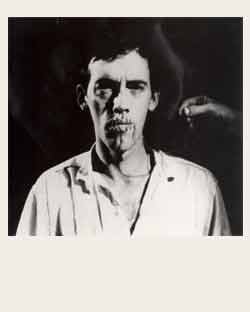Critic!>
In Beckett's Waiting For Godot, when Vladimir and Estragon decide to abuse each other, the worst insult hurled is "Crritic!" The epitaph is so brutal, it ends the exchange.
Echoes of that scornful contempt were resounding throughout the UB Center for the Arts screening room Wednesday night as well-known author and feminist Lucy Lippard took great pains to explain to her audience and fellow panelists that she completely disavowed the term "critic" when applied to what she does. I'm not going to analyze her reasons for rejecting the term--they seemed to center around wanting to be an advocate for artists rather than a potential "disser" from the outside--but when someone as prominent as Lippard makes dismissive remarks about being a critic, people listen. I have long respected Lippard as one of the most proactive and wide-ranging art critics (my term) working today, so I was a bit dismayed to hear the role of the critic reduced to the simplistic dimension of being "for" or "against" artists. I'd like to offer some views on art critics and art criticism that weren't heard or discussed that night.
I've never minded being called a critic, even when the term has been used as a indictment rather than as a description. What I do mind is when people ask me--and this has happened a lot--if I also "paint or something." This query has at least two possible subtexts: 1.) If I'm not making art, why am I so interested in writing about it? or 2.) Writing about something can only be a secondary activity to actual "creative" work; therefore my criticism must be a sideline to what I really want to do (like being a waiter when you're really an actor). Well, I like to write about the act of expression and the ideas behind it; I call this criticism and I think it's considerably more than a hobby or a way to pay the rent (and that's another story).

Although I'm nowhere near acheiving it, my goal in writing criticism has
been to provoke dialogue and response to works of art, to share with others
a process of working out ideas and concepts, and to report on what I find
notable in how others have worked out their ideas. Institutional critiques
and continual analysis of criticism itself are also an important part
of this process. You may start out talking about individual artworks,
but what you end up doing is talking about issues--issues of politics,
identity, psychology, aesthetics, history...the issues of how we live
our lives in the world.
The importance of criticism is such that any artist who intends to be more than an interior decorator must also be a critic, in thought if not in actual printed deed. It's not enough to just make something--you also have to have a reason for doing it and be able to thoughtfully analyze how your execution corresponds to your motivation. That's the most ruthless type of criticism artists have to do. But there's also the task of learning how to look at the work of other artists, the ongoing process of absorbing influences and generating dialogues. If artists weren't also critics, I don't think we'd have an art history worth writing a pamphlet about. Although artists have written formal art criticism (Donald Judd comes to mind), it's even more significant that a huge number of actual artworks have operated as vital statements of art criticism as well as individual expression: Manet's Olympia, Cezanne's Bathers, and a large proportion of the oeuvres of artists Marcel Duchamp, Andy Warhol, Robert Colescott, and Pat Steir, just to name a few examples.
Speaking more specifically about criticism, and getting back to the night of the Lippard panel, I have more important reasons for bringing up this topic than the simple, reflexive act of defending my own part in it. That night, I had hoped to hear some discussion of the critique of so-called "multicultural" art. My working definition of this term is art which redefines the framework of mainstream art history, providing important, illuminating and previously overlooked reference points from which to survey the global range of art-making. Of course, if the mainstream art establishment (museums, historians, patrons, government funders--wherever the power and the money are) wasn't so invariably narrow-minded in its definitions of art, all art would be "multicultural." (As Lippard pointed out that night.) So far, in the media--including the art press--discussion of this topic has been frighteningly polarized. Some critics--such as Lippard--champion artists whose practice challenges mainstream notions of art; some critics--such as Robert Hughes--demand that all art worth canonizing measure up to some internalized standard of "quality" based on Euro-Western formal traditions. You know, Manet begat Cezanne, Cezanne begat Braque, Braque begat Leger, etc., etc. (Gee, I hope I have this right.) The arguments are so repetitive and clichéd that I hate even having to summarize them. And usually they're focused on the work of a single artist, or a single exhibition. Since the people harping on "quality" have the most to defend, their voices have been dominating the scene.
For anything constructive to come of all this, critics will have to forget their carefully rehearsed rationales and retorts and start talking to one another. More panels like the Lippard evening will need to take place but rather than shying away from issues, participants will have to be quite daring about asking questions like, "How do we recognize important art? "How are these standards constructed?" and "Why is it so important to exclude?"
For anything to change in the art world, we'll all have to be critics.
Artvoice, 1996

